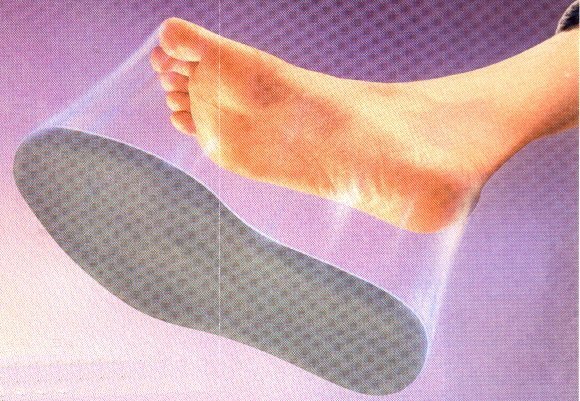
undefined
undefined
- Do you suffer
from corns, calluses, bunions?
- Foot or leg
aches?
- Pain in your
heels or hips?
-
- Foot pain can be a symptom
of other problems.
-
- Certainly, foot pain is
enough to make you irritable. But did you know that foot
symptoms can mean you are suffering from some kind of
postural problem? If you're like 80% of the population,
you suffer on occasion from hip, back and neck
complaints, many of which can be traced to a malfunction
in the feet.
-
- A study by The Langer
Biomechanics Group, the largest custom orthotic
laboratory in the world, shows that four out of five
people in the United States have a foot problem that is
significant enough to cause symptoms at some time in
their lives. Factors such as occupation, recreational
activities and environmental stresses cause your body to
compensate for deficiencies and abnormalities in the
functioning of your foot.
-
- How your
feet work.
-
- Your foot is made up of 26
bones that function first as a mobile adapter, then as a
shock absorber for the rest of your body. During the
mobile adapter phase of walking or running, the foot is a
"loose bag of bones" that can be placed on any
surface and still help maintain the equilibrium of your
leg and body above. As adaptable as your foot's structure
must be, it must also be capable of locking itself into a
rigid structure so that it can act as a lever, first to
stabilize and lift your body's weight and then to propel
it forward.
-

- The timing of your gait is
as important as the foot's structure. When timing is off,
the body's weight and stress enter the foot at a time
when it is not prepared to receive it. This results in an
unstable foot that has bones moving in abnormal
directions through abnormal ranges of motion.
-
- Over the years, if your foot
function is poor, your feet will functionally adapt.
Therefore, when the doctor examines you, knowledge of
biomechanics and anatomy must be applied to mentally
reconstruct the feet to how they appeared and worked
before the alterations caused by years of activity and
environmental stresses.
-
- Unaware of these slow
adaptations that occur over the years, most people tend
to ignore their feet until they are in pain. Then they
will seek the advice of a medical specialist who will
work toward relieving symptoms and correcting their
condition.
-
- Correction
of Foot Function with
- Biomechanical
Orthotic Devices
-
- Often, as a part of
biomechanical treatment, an orthotic device is
custom-made for the patient. These prescription devices
create more normal foot function of the feet and legs by
maintaining the anatomical angular relationships between
the segments of each foot and leg. Components called
control posts, added to the front, rear or both ends, are
ground to specific angles. These control posts cause the
orthotic device to move or subtly rock into specific
positions at specific times in the gait or walking cycle.
This action controls abnormal motion without restricting
normal motion and eliminates the jarring effect commonly
associated with conventional arch supports. A truly
biomechanically-designed orthotic device will decrease or
eliminate foot symptoms, corns and calluses. And very
often, this prescription orthotic can reduce leg and back
fatigue resulting from using the wrong muscles at the
wrong time.
-
- Beginning
Biomechanical Treatment
-
- Your medical specialist will
make casts of your feet taken in a "neutral"
position, that is, capturing the proper angular
relationships between various segments of each foot.
Models of your feet will be constructed at a laboratory
such as that of The Langer Biomechanics Group, where
doctors and technicians will determine the best
functioning positions. The bodies of the orthotic devices
are contoured and angled over these models.
-
- The material from which the
orthotic is created depends on the degree of control
required, your physical status, daily activities,
occupation, and type of footwear you use. Because they
are custom-made prescription devices, the orthotic will
conform to the desired contours of your feet and will
vary in length and width. The front edge of the orthotic
device may appear smaller than your foot since it always
ends just behind the weight-bearing surfaces of the
metatarsal heads. Because of their design, devices take
up a minimal amount of room in the average shoe.
-
- Hurting
should not be a part of your everyday life.
-
- After a biomechanical
examination, your specialist might recommend orthotic
devices, and other courses of treatment such as
strapping, physical therapy, manipulation or adjustment.
You may also be given a beneficial stretching program to
improve flexibility, depending on your case and physical
capabilities.
-
- By following your doctor's
instructions exactly, you can be on the road to
eliminating painful foot and postural problems.
-
- Remember, you cannot undo in
a few weeks what your body has taken years to create.
-
- Ask questions and express
your concerns; your specialist in biomechanics of the
foot and leg understands that when your feet hurt, you
hurt all over, and has the knowledge to help.
-
 Return to top of Page
Return to top of Page
 Go Back to Menu of Topics
Go Back to Menu of Topics
 Email to Dr. Pat
Email to Dr. Pat
- @copyright
1998 Juan F. Pérez All rights reserved
This page was created
by Juan F. Pérez Designs (561) 832-7571

 Return to top of Page
Return to top of Page